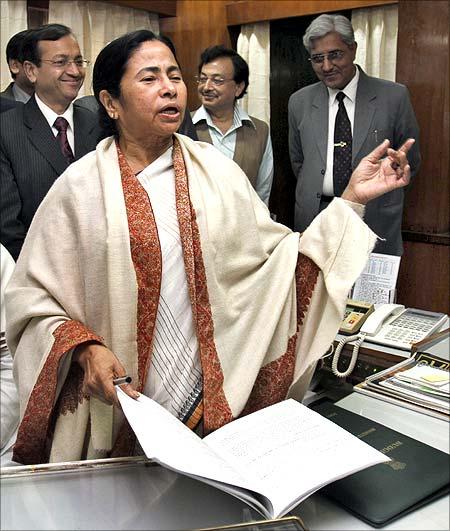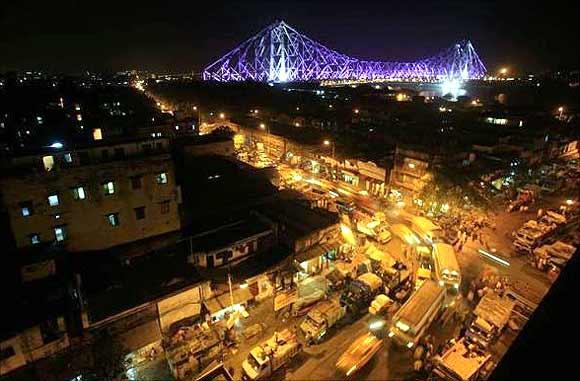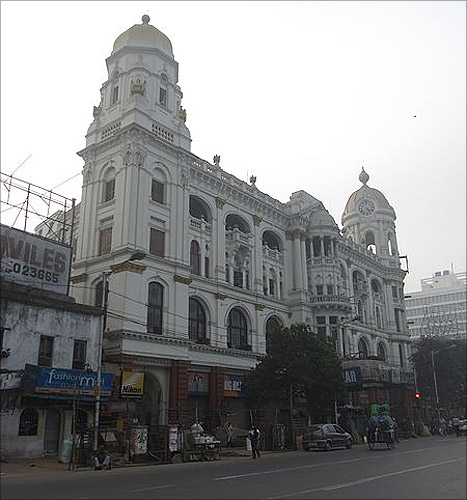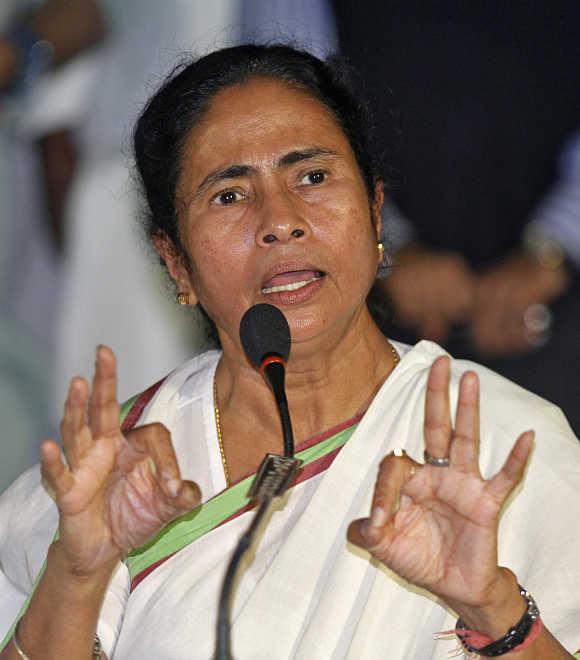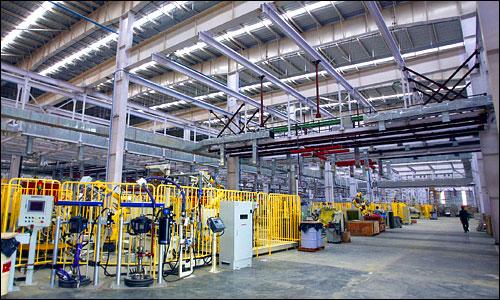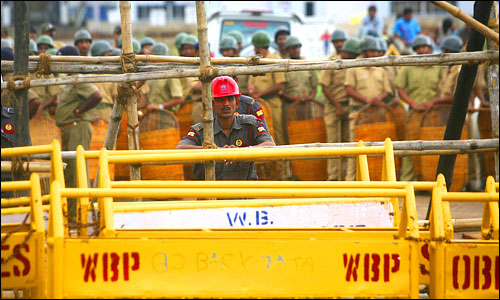 | « Back to article | Print this article |
Is Haldia Mamata's Nano moment?
The share divestment in the troubled petrochem company suffers the same aura of secrecy for which West Bengal's chief minister excoriated the former Left Front government over Tata Motors' small car project, notes Ishita Ayan Dutt
The share divestment in the troubled petrochem company suffers the same aura of secrecy for which West Bengal's chief minister excoriated the former Left Front government over Tata Motors' small car project.
Till recently, Tata Motors’ Nano project was Bengal’s chief enigma to the outside world, its tortuous history of agreement-announcement-pullout an all-consuming passion for local politicians and the national business community in the mid- to late-2000s.
But now, there is competition for that position from the state’s original showcase project, Haldia Petrochemicals Ltd, in which the state government, one of its principal promoters, has just decided to divest its shares in favour of national public sector oil major Indian Oil Corporation, which already owns 8.9 per cent of the company.
The decision, however, was preceded by some peculiar developments that have raised so many questions that people are now wondering whether HPL is Chief Minister Mamata Banerjee’s Nano moment.
Click NEXT to read further. . .
Is Haldia Mamata's Nano moment?
Not remotely in terms of an impact on the electorate, unlike the small car project, the fate of which had a huge influence on the Left Front’s electoral defeat after more than three decades in power.
But there is a significant resemblance nonetheless.
Consider two events: On October 8, companies were to submit bids for government’s 39.99 per cent stake in HPL.
In the evening, when Industry Minister Partha Chatterjee addressed the media, he refused to reveal the number of bidders, forget the names.
It later came to light -- and not from the state government -- that IOC was the sole bidder while Reliance Industries Ltd had sent some sort of communication regarding its interest in HPL that could not be construed to be a bid.
The bids, which were supposed to have been opened on the same evening as they were submitted, were postponed. No explanation was offered, not even to IOC.
Finally, on October 10, the government declared IOC the sole valid bidder.
But no reserve price or bid price has been made public yet.
Figures ranging between Rs 24 and 28 a share are in the air.
So, why this collective opacity on the part of the Banerjee government?
Click NEXT to read further. . .
Is Haldia Mamata's Nano moment?
It is understood that the group of ministers considering the stake sale even deliberated at length whether to re-tender, given that RIL and IOC apart, Cairn India, Essar Energy, GAIL, and ONGC, had evinced interest in eastern India’s largest petrochemical company producing 3.5 million tonnes of polymer.
But the company’s financial health did not permit it.
Last year, HPL posted losses of around Rs 960 crore (Rs 9.6 billion) on revenues of Rs 8,662 crore (Rs 86.62 billion).
Further, it had debts of around Rs 3,500 crore (Rs 35 billion).
Of course, the government won’t tell whether it considered cancelling the stake sale process.
Partha Chatterjee claimed that the non-disclosure of IOC’s bid price was in keeping with the agreement with the Purnendu Chatterjee-led TCG, its 40.87 per cent co-promoter, with which it has an agreement for right of first refusal for its shares.
TCG has a month’s time to match IOC’s bid and another to pay up.
Click NEXT to read further. . .
Is Haldia Mamata's Nano moment?
But a Communist Party of India (Marxist) minister in the earlier government with direct knowledge of the matter clarified that there was no specific clause in the agreement that barred it from disclosing the price.
The agreement just said if the state government wanted to sell its shares, it would have to offer them to TCG first.
Legal experts have a different take on the matter.
All agreements have a general confidentiality clause, and in this specific case such a clause would hardly have been unnatural given that a matter relating to the legal battle between the two parties over the ownership of 155 million shares that is currently being heard in the Supreme Court.
Perhaps, but Partha Chatterjee had said that the government was transparent and would continue to remain so, in the context of HPL, a statement that invoked a sense of deja vu.
That’s because it was Chatterjee, then in opposition, who had made loud calls for transparency in the agreement between the Left Front government and Tata Motors for the small car project in Singur.
Click NEXT to read further. . .
Is Haldia Mamata's Nano moment?
In 2006, it was the relentless pursuit by Buddhadeb Bhattacharjee and Nirupam Sen, respectively chief minister and industry minister then, that got Tata Motors to Bengal.
The announcement of the project was quite dramatic.
Immediately after being sworn in as chief minister for the second term, Bhattacharjee addressed the media at Writers’ Buildings, flanked by Ratan Tata and the Tata brass.
Almost immediately after, the Trinamool Congress, then in opposition, bayed for the agreement between Tata Motors and the West Bengal Industrial Development Corporation to be made public.
It was no secret that Tata Motors had originally planned to set up the project in Uttarakhand, where it already has a factory producing commercial vehicles.
When Bhattacharjee and Sen made a case for the project, they were asked to match the fiscal incentives that the Uttarakhand government had offered the company.
Click NEXT to read further. . .
Is Haldia Mamata's Nano moment?
Initially, Bhattacharjee and Sen refused to make the agreement public, saying it was a ‘trade secret’.
But they finally gave in.
After a year of the opposition relentlessly raising questions over the agreement, Sen read out the extraordinarily generous terms and conditions of the agreement in the Assembly.
Under a directive from the state information commission, the text of the agreement was also uploaded on the WBIDC website, but for all of two days.
After that Tata Motors moved Calcutta High Court and obtained a stay on publicising the agreement.
Bureaucrats said the annexures that were not made public were complex calculations of the incentives that the government matched.
For Tata Motors, it was vital that this information were not made public since it would give out the costing of the Nano.
Though the Trinamool-led agitation against land acquisition in Singur for the Nano small car project eventually prompted the Tata group to pull out in 2008, the agreement continued to haunt Bhattacharjee and Sen even after they lost the Assembly elections in 2011.
Click NEXT to read further. . .
Is Haldia Mamata's Nano moment?
Banerjee slipped into the role of chief minister in 2011 after a victory that routed the Left. It was time to return Singur’s kindness that resurrected her political career, and in the first cabinet meeting it was decided that 400 acres would be returned to those farmers who had unwillingly surrendered their land for the Nano project.
That is yet to happen.
After the second cabinet meeting, Banerjee said the copy of the Tata Motors-WBIDC agreement was with her government and in keeping with her pre-electoral promise it would be made public in two days’ time.
It’s been a couple of years since Banerjee made the promise, but there has been no word or action on it since.
No court has been approached to lift the original injunction.
Perhaps, a matter of small moment?
